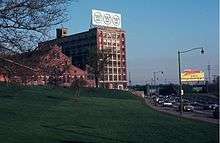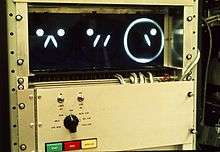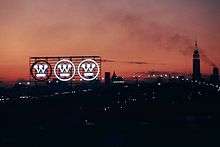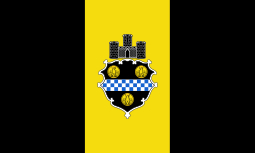Westinghouse Sign
The Westinghouse Sign was the first computer-controlled sign in the United States. Located in Pittsburgh, Pennsylvania, the large animated display advertised the Westinghouse Electric Company, and was best known for the seemingly endless number of combinations in which its individual elements could be illuminated. The sign was removed in 1998 when the building on which it was mounted was demolished to make way for the construction of PNC Park.
| Westinghouse Sign | |
|---|---|
 | |

| |
| General information | |
| Status | Demolished |
| Type | Sign |
| Location | 209 West General Robinson Pittsburgh, Pennsylvania United States |
| Coordinates | 40.447392°N 80.006457°W |
| Completed | 1967 |
| Demolished | 1998 |
History
On December 9, 1948, the Westinghouse Electric Supply Company (Wesco) moved into a new building located at 209 West General Robinson Street in the North Shore section of Pittsburgh.[1] Wesco was a wholesale distributor of electrical apparatus, and a subsidiary of the Westinghouse Electric Company founded by George Westinghouse in 1886.
For many years, a large orange and blue sign on the Wesco roof proclaimed the company's advertising slogan: "You can be sure…if it’s Westinghouse." The sign was pointed to the south, across the Allegheny River, making it easy to see from Downtown Pittsburgh.[2]
Early in 1966, Westinghouse decided to replace the aging advertising sign on the Wesco Building.[3] The idea was to remove the slogan from the existing 200-foot (61 m) support structure, and replace it with a modern view of the Westinghouse corporate identity.[4]
In due course, Richard Huppertz, manager of design coordination at Westinghouse, developed a concept that would bring greater recognition to the 'circle w' logo created by graphic designer Paul Rand.[5] Rather than using words, the sign Huppertz had in mind would rely solely on the Westinghouse corporate mark.[6] The concept was then presented to Paul Rand, who produced a design emphasizing the nine elements of the logo he had illustrated in a 1960 graphics standards guide.[7]
Construction and operation
The Pittsburgh Outdoor Advertising Corporation installed the Westinghouse sign in June 1967 using 3,000 feet (910 m) of neon tubing filled with argon gas, giving the display its characteristic blue color.[8] The sign was composed of nine repetitions of the familiar 'circle w' logo, each of which was 17.5 feet (5.3 m) in diameter and initially divided into nine sections—the enclosing circle, the four diagonal strokes of the W, the three dots above the W, and the bar below—meaning that the entire sign comprised eighty-one individual elements.[9] In later years, an extra element was added to each logo by allowing the top and bottom of the enclosing circle to be independently illuminated. The ninety element configuration increased the number of possible display combinations, but sacrificed the elegance of the original design.
The Wesco Building stood near Three Rivers Stadium, and its sign was one of several large illuminated corporate billboards that became a fixture of Pittsburgh's evening skyline. Among the others were the Alcoa sign atop Mount Washington, and the Clark Bar sign on the D. L. Clark Company Building.
The sign was demolished when the Wesco Building was razed in the autumn of 1998 to make way for PNC Park, which succeeded Three Rivers as the home of the Pittsburgh Pirates.[10] Preservationists attempted to save at least one of the 'circle w' units for eventual display at the Heinz History Center.[11] Alas, both the physical structure and electrical components were in such a state of decay that nothing was salvageable.[12]
Other signs
A second sign was located in Emeryville, California, facing the San Francisco Bay.
Smaller versions of the sign, using three repetitions of the 'circle w' insignia, were erected atop the Westinghouse Outdoor Lighting Plant in Cleveland, Ohio, and on the north side of the Long Island Expressway in Queens, New York.[13]
Photo gallery
 Wesco Building in Pittsburgh, 1967
Wesco Building in Pittsburgh, 1967 Westinghouse sign in Cleveland, 1969
Westinghouse sign in Cleveland, 1969 Sign controller in Cleveland, 1969
Sign controller in Cleveland, 1969 Westinghouse sign in New York, 1972
Westinghouse sign in New York, 1972
Combinations
It was commonly believed that there were practically an infinite number of sequences in which the sign's elements could be lit, and that no sequence was ever repeated. The Westinghouse Electric Corporation encouraged this perception. In reality, the cycle of display patterns would repeat every six minutes, employing a subset of 120 lighting combinations created by Westinghouse designers.[14] To heighten interest in the sign, lighting patterns would be changed from time to time by selecting different sequences from the 120 available displays.[15] A Westinghouse Prodac 50 computer controlled the sign, since it was well-suited to handling repetitive tasks.

See also
References
- "Supply Firm In New Home". Pittsburgh Post-Gazette. 10 December 1948.
- Byrnes, Mark (17 July 2014). "Remembering Pittsburgh's Most Mesmerizing Sign". The Atlantic. ISSN 1072-7825.
- Shaw, Kurt (10 October 2015). "Hot metal: Pittsburgh businesses connected with, promoted Modernist design". Pittsburgh Tribune-Review.
- Huppertz, Richard E. (30 December 1966). "Paul Rand Correspondence". Paul Rand Papers. MS 1745. Manuscripts and Archives, Yale University Library.
- Poulin, Richard (2012). Graphic Design and Architecture, A 20th Century History. Rockport Publishers. pp. 142–143. ISBN 978-1592537792.
- "Westinghouse To Light World's First Computer-Controlled Sign" (Press release). Westinghouse. 13 April 1967.
- Remington, R. Roger (1 October 2003). American Modernism: Graphic Design, 1920 to 1960. Yale University Press. p. 151. ISBN 978-0300098167.
- Reis, Ed (Fall 2010). "Westinghouse W's North Side, Pittsburgh". Western Pennsylvania History. Historical Society of Western Pennsylvania. 93 (3): 27–29. ISSN 1525-4755.
- "Westinghouse Sign". Pittsburgh Press. 16 January 1968. p. 49.
- Barnes, Tom (30 September 1998). "Work begins on PNC Park site". Pittsburgh Post-Gazette.
- "Can One or More Ws Be Saved?". Pittsburgh Post-Gazette. 1 September 1998. p. B-4.
- Barnes, Tom (25 September 1998). "Stadium body loan will speed land purchases". Pittsburgh Post-Gazette. p. A-23.
- "Computer To Operate Novel Sign On Plant". The Gettysburg Times. 18 September 1969. p. 12.
- Heidekat, George (16 November 2015). "How Westinghouse Brought 'Midcentury Modern' to the Pittsburgher on the Street". Carnegie Museum of Art.
- Stieg, Bill (20 March 1980). "The Neon Ads That Light Up Our Lives". Pittsburgh Post-Gazette.
External links
| Wikimedia Commons has media related to Westinghouse Sign. |
- Archival photograph of the Wesco Building
- "Westinghouse Sign (ca. 1967)" on YouTube
- "Westinghouse Sign Replica (2014)" on YouTube
- "Westinghouse Sign 2015" on YouTube
